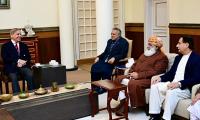Exactly 28 years ago, it was a Christmas night when the unbelievable news about the dissolution of the USSR emerged on media. Nobody was willing to believe that the Soviet Union, which was a superpower, was going to collapse in such a way.
The USSR was a prominent global player of the last century. It was the second largest economy of the world. People belonging to more than 100 ethnicities were living there. The Soviet border was the longest border of any country. It played pivotal role against the defeat of Nazi Germany during World War II. The USSR was also a nuclear power, and invented many weapons, including the Kalashnikov.
The education system of the Soviet states was considered one of the best. Soviet scientists, researchers and innovators were very prominent at the international level. It was the Soviet Union which sent the first satellite and astronaut to space. The USSR was giving a tough time to its rival superpower, the US, at every level.
During the cold war era, the world community was literally divided into two blocs. The USSR’s role was very crucial in the success of various revolutions, including Cuba, Vietnam, and the Middle East. Even, today many revolutionaries are inspired from Soviet ideologies. Rather than only economic and military power, the USSR was also leading the world in the fields of arts, science and culture.
Keeping the above in view, the downfall of the USSR is a very interesting incident of modern history. In my view, the most important factor behind this was the leadership of the last Soviet president, Gorbachev, who failed to keep the country united. Due to an economic crisis, people were in trouble. Ukraine was the first one to break ties with the union. As many as 10 republics had announced sovereignty. Various republics, including Estonia, Latvia, and Lithuania were interested to become independent members of the UN. Internal turmoil was forcing Gorbachev to step down.
Reportedly, the leaders of Russia, Ukraine, and Belarus held a meeting for agreement on the dissolution of the Soviet Union. Authoritarian rule and press censorship were the main hurdles in the way of such developments making it to the international world. However, analysts keeping a close eye on the situation were hinting that the USSR would collapse in the near future.
On December 25, 1991 Gorbachev announced his resignation as president of the USSR. “I hereby discontinue my activities at the post of president of the Union of Soviet Socialist Republics.” On the same day, Russia’s official name was changed from ‘Russian Soviet Federative Socialist Republic’ to the ‘Russian Federation’.
Just after the departure of Gorbachev from the Kremlin, the Soviet flag was lowered and replaced by the Russian flag. Similarly, the national anthem of the Soviet Union was played for the last time, and the Moscow-based state television channel also broadcast the Russian flag. These were symbolic indications for marking the end of the superpower once known as the USSR.
India was one of the closest allies of the USSR. In my view, there are also many similarities between them. Both countries consist of a large area, and interested in becoming global players. Like the USSR of yore, there are also a number of ethnicities living in India, and a number of languages being spoken.
Indian nationals are also playing a pivotal role in every field of life. IT experts from India are considered one of best throughout the world. Since Independence, India has been quoted as a bright example of diplomacy and democracy. The Indian model of secularism is also acknowledged across the world.
However, the current Indian leadership seems to be sabotaging the original image of India. The controversial citizenship act has resulted in creating anarchy at a large scale. People are on the roads to record their protest. Many Indian states are reluctant to implement the newly-passed bill.
There is another interesting fact: the USSR was finally collapsed after 74 years of its formation. Indian PM Narendra Modi’s extremist policies are becoming a threat to internal integrity and regional security. The major reason for the USSR’s collapse was Afghanistan. The longstanding dispute of Kashmir is also a source of tension between India and Pakistan. The Indian leadership must learn lessons from the collapse of the Soviet Union. India should understand that making people suffer and violating citizen rights always results in anarchy and chaos
The writer is a member of the National
Assembly and patron-in-chief of the Pakistan Hindu Council.
Twitter: @RVankwani
Many people believe that in future, AI will play an even more significant role in their lives
In April 2024, three Chinese and one Belarusian company were sanctioned for exporting missile-enabling technology to...
Pakistan has second highest neonatal mortality in world; in education sector, country's 26 million kids are out of...
Key actors in global power politics are US, China, Russia, European Union, and emerging powers such as India and Brazil
Maulana Fazl manages to bring together factions that historically stand opposed
NASA says August 2024 set new monthly temperature record, capping Earth’s hottest summer since 1880







